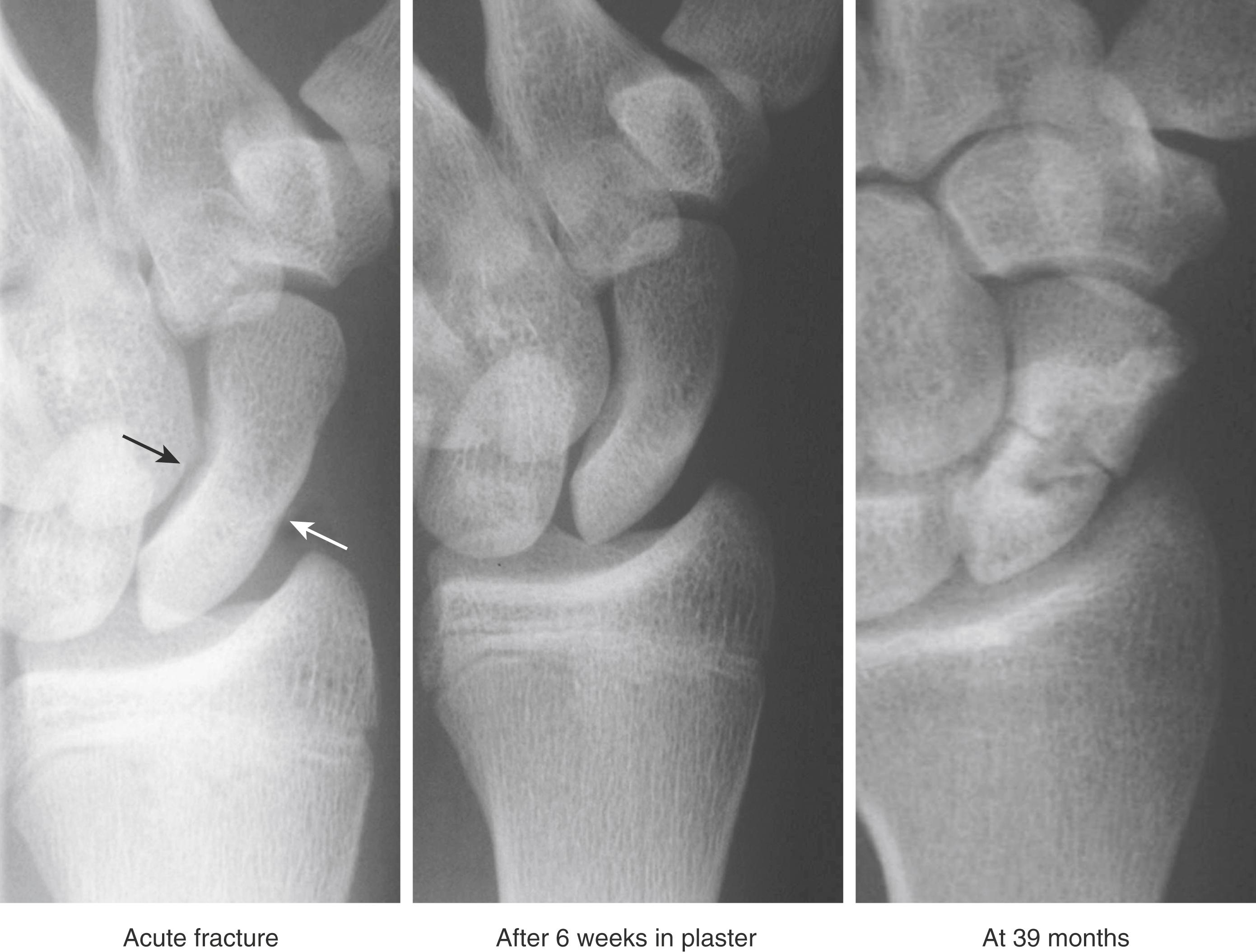Physical Address
304 North Cardinal St.
Dorchester Center, MA 02124
Accessory bones of the wrist are relatively uncommon, with a reported incidence of 0.75% to 2.0% ( Fig. 97.1 ). They are thought to be a remnant of separate ossification centers found in the human embryo and in some other, but not all, African primates. The most common of these accessory bones of the wrist is called os centrale carpi. In most humans, this ossification center fuses with the scaphoid bone by 8 weeks of gestation. In the gibbon and orangutan, it remains a separate distinct bone that does not fuse with the scaphoid until old age.

Located among the capitates, scaphoid, and trapezium bones, os centrale carpi is often mistaken for a scaphoid fracture or a bipartite scaphoid, or it is simply identified as a serendipitous finding on imaging of the wrist ( Figs. 97.2 and 97.3 ; Table 97.1 ). It may be either unilateral or bilateral, further adding to the clinician’s confusion. The key to differentiating os centrale carpi from a scaphoid fracture is the characteristic smoothness of the borders of the accessory ossicle in relationship to the other carpal bones. In questionable cases, radionuclide scanning, computed tomography, and magnetic resonance imaging (MRI) may be helpful in making the differential diagnosis. Os centrale carpi may exist as an isolated asymptomatic or symptomatic abnormality or may occur in conjunction with a number of heritable syndromes ( Box 97.1 ).


| Os Centrale Carpi | Acute Scaphoid Fracture | Old Scaphoid Fracture | Bipartite Scaphoid |
| Smooth borders | Irregular borders | Demineralization and cystic degeneration | Radiolucency at waist of scaphoid rather than its borders |
Hand-foot-uterus syndrome
Holt–Oram syndrome
Larsen syndrome
Taybi otopalatodigital syndrome
Wrist pain secondary to os centrale carpi is characterized by tenderness and pain over the dorsoradial wrist. The patient often feels as though he or she has gravel in the wrist and may report a severe grating sensation with range of motion of the wrist. The pain of os centrale carpi worsens with activities that require repeated twisting motions, such as tightening lids on jars. Os centrale carpi may coexist with tendinitis of the wrist.
On physical examination, pain can be reproduced by pressure on the os centrale carpi. In contradistinction to the pain of acute scaphoid fracture, in which the tender area is localized over the anatomic snuffbox, with os centrale carpi the area of maximum tenderness will be just above the accessory ossicle. A creaking or grating may be appreciated by the examiner, and locking or catching on range of motion of the wrist may occasionally be present.
Plain radiographs are indicated for all patients with os centrale carpi to rule out fractures and to identify other accessory ossicles that may have become inflamed ( Fig. 97.4 ). Plain radiographs will also often identify loose bodies or joint mice that may also be present. On the basis of the patient’s clinical presentation, additional testing, including complete blood cell count, sedimentation rate, and antinuclear antibody testing, may be indicated. MRI of the wrist joint is indicated if joint instability, occult mass, or tumor is suspected and to further clarify the diagnosis. Radionuclide bone scanning may be useful in the identification of stress fractures or tumors of the wrist that may be missed on plain radiographs. Arthrocentesis of the wrist joint may be indicated if septic arthritis or crystal arthropathy is suspected.

Os centrale carpi pain syndrome is a clinical diagnosis that is supported by a combination of clinical history, physical examination, radiography, and MRI. Pain syndromes that may mimic os centrale carpi pain syndrome include primary disease of the wrist, including gout and occult fractures, and bursitis and tendinitis of the wrist, both of which may coexist with os centrale carpi. Osteochondritis dissecans, carpal coalition syndrome, and synovial chondromatosis may also mimic the pain associated with os centrale carpi. Primary and metastatic tumors of the wrist may also manifest in a manner analogous to wrist pain secondary to os centrale carpi.
Become a Clinical Tree membership for Full access and enjoy Unlimited articles
If you are a member. Log in here